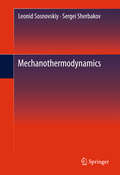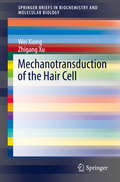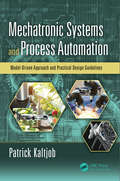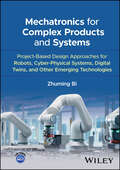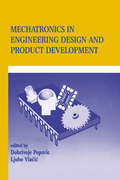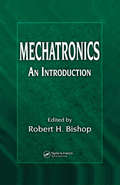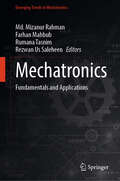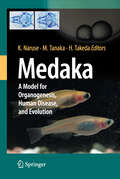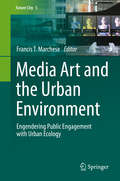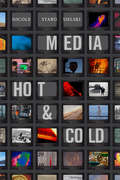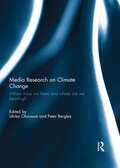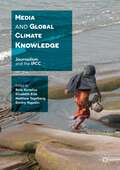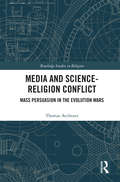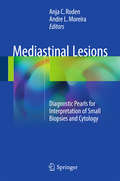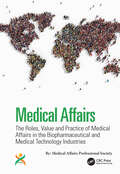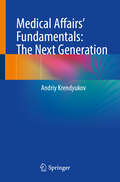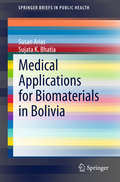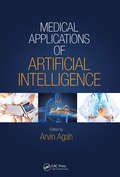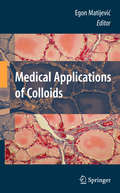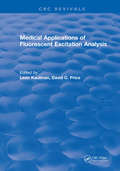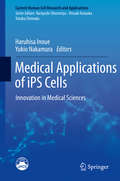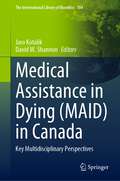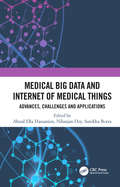- Table View
- List View
Mechanothermodynamics
by Leonid Sosnovskiy Sergei SherbakovThis monograph addresses the foundations of mechanothermodynamics and analyzes two of its key principles--damage of everything that exists has no conceivable limits, and effective energy (entropy) flows caused by loads of a different nature do not have a cumulative property; they interact dialectically. The authors examine a generalized model of energy and entropy states of a mechanothermodynamical medium, which generally is a continuum (liquid, gaseous) containing distributed solid deformable, and, therefore, damageable bodies, as a problem of information states of movable and damageable systems and express a solution in the first approximation. The book goes on to analyze some directions of further research in its conclusion. It is ideal for scientists, engineers, post graduate and master students of mechanics, mathematics and physics.
Mechanotransduction of the Hair Cell (Springerbriefs In Biochemistry And Molecular Biology Ser.)
by Wei Xiong Zhigang XuThis book summarizes the emerging experimental evidence on hair-cell mechanotransduction, and covers hair’s cellular structure, biophysical properties, molecular components and functions. Auditory hair cells convert sound-induced vibration into electrical signals. This biological process, mechanotransduction, is what allows us to hear and communicate in our daily lives. However, our grasp of hair-cell mechanotransduction is still far from complete. Recent advances in molecular genetics and biophysics have helped us gain deeper insights into this process, especially the molecular constituent and operation of the channel complex. This book provides a cutting-edge snapshot for all readers who are interested in or studying how auditory hair cells detect sound.
Mechatronic Systems and Process Automation: Model-Driven Approach and Practical Design Guidelines
by Patrick O.J. KaltjobThe book discusses the concept of process automation and mechatronic system design, while offering a unified approach and methodology for the modeling, analysis, automation and control, networking, monitoring, and sensing of various machines and processes from single electrical-driven machines to large-scale industrial process operations. This step-by-step guide covers design applications from various engineering disciplines (mechanical, chemical, electrical, computer, biomedical) through real-life mechatronics problems and industrial automation case studies with topics such as manufacturing, power grid, cement production, wind generator, oil refining, incubator, etc. Provides step-by-step procedures for the modeling, analysis, control and automation, networking, monitoring, and sensing of single electrical-driven machines to large-scale industrial process operations. Presents model-based theory and practice guidelines for mechatronics system and process automation design. Includes worked examples in every chapter and numerous end-of-chapter real-life exercises, problems, and case studies.
Mechatronics for Complex Products and Systems: Project-Based Design Approaches for Robots, Cyber-Physical Systems, Digital Twins, and Other Emerging Technologies
by Zhuming BiA project-based approach to designing mechatronic systems with new and emerging technologies In Mechatronics for Complex Products and Systems: Project-Based Designs for Cyber-Physical Systems, Digital Twins, and Other Emerging Technologies, distinguished researcher Dr. Zhuming Bi delivers an expert discussion of real-world mechatronics skills that students will need in their engineering careers. The book explains the characteristics and innovation principles underlying mechatronic systems, including modularization, adaptability, predictability, sustainability, and concurrent engineering. A mechatronic system is decomposed into a set of mechatronic functional modules such as power systems, actuating systems, sensing systems, systems of signal conditioning and processing, and control systems. The author also offers: A thorough introduction from classic integration of mechanical, electronic and electrical systems to more complex products and systems, including cyber-physical systems, robotics, human-robot interactions, digital twins, and Internet of Things applications Insightful project assignments that help reinforce a practical understanding of a learning subject Practical discussions of real-world engineering problems Comprehensive guidance on how to select the right type of sensors, motors, and controllers for a variety of mechatronic functional modules Perfect for advanced undergraduate and graduate students of mechatronics, Mechatronics for Complex Products and Systems will also benefit professional engineers working on interdisciplinary projects enabled by digital technologies, Internet of Things (IoT), and Artificial Intelligence (AI).
Mechatronics in Engineering Design and Product Development
by Dobrivojie PopovichThis work presents a systematic and comprehensive overview to the theory and applications of mechatronic processes, emphasizing the adaptation and incorporation of this important tool in fulfilling desired performance and quality requirements. The authors address the core technologies needed for the design and development of the mechatronic product
Mechatronics: An Introduction (Electrical Engineering Handbook Ser.)
by Robert H. BishopMechatronics has evolved into a way of life in engineering practice, and it pervades virtually every aspect of the modern world. In chapters drawn from the bestselling and now standard engineering reference, The Mechatronics Handbook, this book introduces the vibrant field of mechatronics and its key elements: physical system modeling; sensors and actuators; signals and systems; computers and logic systems; and software and data acquisition. These chapters, written by leading academics and practitioners, were carefully selected and organized to provide an accessible, general outline of the subject ideal for non-specialists.Mechatronics: An Introduction first defines and organizes the key elements of mechatronics, exploring design approach, system interfacing, instrumentation, control systems, and microprocessor-based controllers and microelectronics. It then surveys physical system modeling, introducing MEMS along with modeling and simulation. Coverage then moves to essential elements of sensors and actuators, including characteristics and fundamentals of time and frequency, followed by control systems and subsystems, computer hardware, logic, system interfaces, communication and computer networking, data acquisition, and computer-based instrumentation systems. Clear explanations and nearly 200 illustrations help bring the subject to life.Providing a broad overview of the fundamental aspects of the field, Mechatronics: An Introduction is an ideal primer for those new to the field, a handy review for those already familiar with the technology, and a friendly introduction for anyone who is curious about mechatronics.
Mechatronics: Fundamentals and Applications (Emerging Trends in Mechatronics)
by Md. Mizanur Rahman Farhan Mahbub Rumana Tasnim Rezwan Us SaleheenThis book emphasizes on the relevant methodologies that encompass modelling, design approaches, and control of mechatronic systems. In addition, state-of-the-art technologies like artificial intelligence, machine learning, and computational intelligence in mechatronics are explored in this book, illustrating various examples, recent advancements, and case studies from real-world implementations. This book further investigates and unleashes the power of the Internet of Things (IoT), showcasing how it transforms today’s rapidly changing industries by impeccably integrating smart devices and creating interconnected systems. This book serves as a reference tool for students, academics, practitioners, researchers, and industrial leaders in the respective fields.
Medaka
by Hiroyuki Takeda Kiyoshi Naruse Minoru TanakaOryzias latipes, known as medaka, is a model organism from East Asia. Breeding of this small, egg-laying freshwater teleost fish has long been popular among hobbyists in Japan. Now, as biological science has entered the genome era, the medaka provides significant advantages that make it one of the most valuable vertebrate models: a large collection of spontaneous mutants collected over a century, the presence of highly polymorphic inbred lines established over decades, and a recently completed genome sequence. This book is the first comprehensive monograph to cover a variety of medaka research. It opens with a historical view of medaka, followed by a series of research topics in the four major areas where the medaka is increasingly important: genomics, genetics, and resources; organogenesis and disease models; germ cells, sex determination, and reproduction; and evolution. Readers will find state-of-the-art information on medaka genetics and genomics such as the first isolation of active transposons in vertebrates, the influence of chromatin structure on sequence variation, fine QTL analysis, and versatile mutants as human disease models.
Media Art and the Urban Environment
by Francis T. MarcheseThis text formally appraises the innovative ways new media artists engage urban ecology. Highlighting the role of artists as agents of technological change, the work reviews new modes of seeing, representing and connecting within the urban setting. The book describes how technology can be exploited in order to create artworks that transcend the technology's original purpose, thus expanding the language of environmental engagement whilst also demonstrating a clear understanding of the societal issues and values being addressed. Features: assesses how data from smart cities may be used to create artworks that can recast residents' understanding of urban space; examines transformations of urban space through the reimagining of urban information; discusses the engagement of urban residents with street art, including collaborative community art projects and public digital media installations; presents perspectives from a diverse range of practicing artists, architects, urban planners and critical theorists.
Media Hot and Cold (Elements)
by Nicole StarosielskiIn Media Hot and Cold Nicole Starosielski examines the cultural dimensions of temperature to theorize the ways heat and cold can be used as a means of communication, subjugation, and control. Diving into the history of thermal media, from infrared cameras to thermostats to torture sweatboxes, Starosielski explores the many meanings and messages of temperature. During the twentieth century, heat and cold were broadcast through mass thermal media. Today, digital thermal media such as bodily air conditioners offer personalized forms of thermal communication and comfort. Although these new media promise to help mitigate the uneven effects of climate change, Starosielski shows how they can operate as a form of biopower by determining who has the ability to control their own thermal environment. In this way, thermal media can enact thermal violence in ways that reinforce racialized, colonial, gendered, and sexualized hierarchies. By outlining how the control of temperature reveals power relations, Starosielski offers a framework to better understand the dramatic transformations of hot and cold media in the twenty-first century.
Media Research on Climate Change: Where have we been and where are we heading?
by Ulrika Olausson and Peter BerglezResearch on media coverage of climate change, as a particular subfield of environmental communication research, has proliferated over the past decade. This book sets out to consider what conclusions can be drawn in light of the existing body of work, what lessons can be learnt, what are the challenges to be met, and what are the directions to be taken in order to further develop media research on climate change. The mixture of articles in this volume serve well to illustrate the range of empirical, theoretical, and methodological approaches subsumed under the broad heading of "media studies on climate change." Some contributions focus on the past—how the subfield has developed and what we can learn from that—and some look toward the future. Either way, all the authors share the ambition to suggest important avenues of research, be they centered on media, context, applicability of results, or theoretical advancement. As such they make a valuable contribution to identifying important directions for future research on the role of the media in communicating climate change. This book was previously published as a special issue of Environmental Communication.
Media and Global Climate Knowledge: Journalism and the IPCC
by Risto Kunelius Elisabeth Eide Matthew Tegelberg Dmitry YagodinThis book is a broad and detailed case study of how journalists in more than 20 countries worldwide covered the Intergovernmental Panel on Climate Change (IPCC) Fifth Assessment (AR5) reports on the state of scientific knowledge relevant to climate change. Journalism, it demonstrates, is a key element in the transnational communication infrastructure of climate politics. It examines variations of coverage in different countries and locations all over the world. It looks at how IPCC scientists review the role of media, reflects on how media relate to decision-making structures and cultures, analyzes how key journalists reflect on the challenges of covering climate change, and shows how the message of IPCC was distributed in the global networks of social media.
Media and Science-Religion Conflict: Mass Persuasion in the Evolution Wars (Routledge Studies in Religion)
by Thomas AechtnerThis book examines why the religion-science skirmishes known as the Evolution Wars have persisted into the 21st century. It does so by considering the influences of mass media in relation to decision-making research and the Elaboration Likelihood Model, one of the most authoritative persuasion theories. The book’s analysis concentrates on the expression of cues, or cognitive mental shortcuts, in Darwin-sceptic and counter-creationist broadcasts. A multiyear collection of media generated by the most prominent Darwin-sceptic organizations is surveyed, along with rival publications from supporters of evolutionary theory described as the pro-evolutionists. The analysed materials include works produced by Young Earth Creationist and Intelligent Design media makers, New Atheist pacesetters, as well as both agnostic and religious supporters of evolution. These cues are shown to function as subtle but effective means of shaping public opinion, including appeals to expertise, claims that ideas are being censored, and the tactical use of statistics and technical jargon. Contending that persuasive mass media is a decisive component of science-religion controversies, this book will be of keen interest to scholars of Religion, Science and Religion interactions, as well as researchers of Media and Communication Studies more generally.
Media and the Mind: Art, Science, and Notebooks as Paper Machines, 1700-1830
by Matthew Daniel EddyA beautifully illustrated argument that reveals notebooks as extraordinary paper machines that transformed knowledge on the page and in the mind. We often think of reason as a fixed entity, as a definitive body of facts that do not change over time. But during the Enlightenment, reason also was seen as a process, as a set of skills enacted on a daily basis. How, why, and where were these skills learned? Concentrating on Scottish students living during the long eighteenth century, this book argues that notebooks were paper machines and that notekeeping was a capability-building exercise that enabled young notekeepers to mobilize everyday handwritten and printed forms of material and visual media in a way that empowered them to judge and enact the enlightened principles they encountered in the classroom. Covering a rich selection of material ranging from simple scribbles to intricate watercolor diagrams, the book reinterprets John Locke’s comparison of the mind to a blank piece of paper, the tabula rasa. Although one of the most recognizable metaphors of the British Enlightenment, scholars seldom consider why it was so successful for those who used it. Each chapter uses one core notekeeping skill to reveal the fascinating world of material culture that enabled students in the arts, sciences, and humanities to transform the tabula rasa metaphor into a dynamic cognitive model. Starting in the home, moving to schools, and ending with universities, the book reconstructs the relationship between media and the mind from the bottom up. It reveals that the cognitive skills required to make and use notebooks were not simply aids to reason; rather, they were part of reason itself.
Mediastinal Lesions
by Anja C. Roden Andre L. MoreiraThis book addresses the current concepts in tissue acquisition, diagnosis, and classification of mediastinal lesions in small biopsies including cytology. Examples of mediastinal diseases that are either more common, more challenging to diagnose, or have a differential diagnosis that is important and might require different modes of treatment are highlighted. The knowledge of some key morphologic features and immunohistochemical pitfalls will be helpful for the practicing pathologist to tackle this challenge. The general workup of a mediastinal biopsy and the workup of major disease groups in mediastinal pathology which the general pathologist should be familiar with is discussed. Morphologic and, if applicable, immunophenotypic and molecular features that can help to distinguish these disease entities are highlighted. Furthermore, the reader will learn about the pertinent clinical implications of the diseases. Mediastinal Lesions: Diagnostic Pearls for Interpretation of Small Biopsies and Cytology will be a reference guide for pathologists, pathologists-in-training, and allied professionals, including oncologists, pulmonologists, surgeons, and radiologists.
Mediation in Collective Labor Conflicts (Industrial Relations & Conflict Management)
by Ana Belén García Martin C. Euwema Francisco J. Medina Erica Romero PenderThis open access book opens up the black box of mediation in collective conflicts through the analyses and comparisons of various systems. Mediation and related third party interventions such as conciliation and facilitation are discussed as effective prevention and regulation tools for different types of collective labor conflicts. These interventions fit in a new developed five-phase model of collective conflicts in organizations, going from capacity building in latent conflicts, through conciliation, mediation and arbitration in escalating phases, to rebuilding of trust after hot conflicts. The authors promote understanding and discussion with regards to labor mediation systems, presenting comparative research on the perspectives of mediators and users of mediation. This book describes and analyses laws, regulations and practices of mediation in seventeen countries, with a relative strong emphasis on Europe. Part 1 presents theoretical frameworks on conciliation and mediation in collective labor conflicts. Part 2 presents regulations and practices in 12 European countries: Belgium, Denmark, Estonia, France, Italy, Poland, Portugal, Spain, The Netherlands, and the United Kingdom. Part 3 discusses mediation in these collective conflicts in Australia, China, India, South Africa and the USA. Part 4 offers conclusions and ways forward. This book offers analyses, good practices and developments for third party intervention in collective labor conflicts in global and local changing environments. This book is a must-read for policy makers, , social partners at different levels, as well as scholars and practitioners in industrial relations, human resources management and conflict management, particularly conciliators and mediators.
Medical Affairs: The Roles, Value and Practice of Medical Affairs in the Biopharmaceutical and Medical Technology Industries
by Kirk Shepard, Charlotte Kremer, Garth SundemMedical Affairs is one of the three strategic pillars of the pharmaceutical and MedTech industries, but while clear career paths exist for Commercial and Research and Development, there is no formal training structure for Medical Affairs professionals. Medical and scientific expertise is a prerequisite for entry into the function, and many people transitioning into Medical Affairs have advanced degrees such as PhD, MD, or PharmD. However, these clinical/scientific experts may not be especially well-versed in aspects of industry such as the drug development lifecycle, crossfunctional collaborations within industry, and digital tools that are transforming the ways Medical Affairs generates and disseminates knowledge. This primer for aspiring and early-career Medical Affairs professionals equips readers with the baseline skills and understanding to excel across roles.Features: Defines the purpose and value of Medical Affairs and provides clear career paths for scientific experts seeking their place within the pharmaceutical and MedTech industries. Provides guideance and baseline competencies for roles within Medical Affairs including Medical Communications, Evidence Generation, Field Medical, Compliance, and many others. Specifies the "true north" of the Medical Affairs profession as ensuring patients receive maximum benefit from industry innovations including drugs, diagnostics and devices. Presents the purpose and specific roles of Medical Affairs roles across organization types including biotechs, small/medium/large pharma and device/diagnostic companies, taking into account adjustments in the practic of Medical Affairs to meet the needs of developing fields such as rare disease and gene therapy. Leverages the expertise of over 60 Medical Affairs leaders across companies, representing the first unified, global understanding of the Medical Affairs profession.
Medical Affairs’ Fundamentals: The Next Generation
by Andriy KrendyukovThis book explores the evolving and strategic leadership role of Medical Affairs within the pharmaceutical industry—an area uniquely positioned at the intersection of clinical science, product development, and stakeholder engagement. Spanning all phases of the medicinal product lifecycle, Medical Affairs functions as a critical bridge between industry and the broader medical community. Success in this role demands a robust, interdisciplinary skill set encompassing scientific, clinical, regulatory, and strategic competencies. The accelerating pace of technological advancement, digital transformation, and integration of artificial intelligence is reshaping the landscape of healthcare and Medical Affairs alike. Simultaneously, healthcare systems face increasing resource constraints, while the burden of chronic disease rises and treatment options expand. In this complex environment, the success of innovative medicinal products depends not only on clinical efficacy but also on demonstrating economic value to a broad array of stakeholders, including patients, healthcare professionals, payers, regulators, and medical societies. Products that integrate the needs of these stakeholders early in development and commercialization are positioned to deliver the highest value. The book is structured in three parts: Part I outlines the mission, values, and overarching objectives of Medical Affairs. Part II delivers practical, in-depth guidance on the foundational principles and essential functions of Medical Affairs, with dedicated chapters on key activities. <li class="MsoNormal" style="mso-margin-top-alt: auto; mso-margin-bottom-alt: au
Medical Applications for Biomaterials in Bolivia
by Sujata K. Bhatia Susan AriasThis book investigates the potential medical benefits natural biomaterials can offer in developing countries by analyzing the case of Bolivia. The book explores the medical and health related applications of Bolivian commodities: quinoa, barley, sugarcane, corn, sorghum and sunflower seeds. This book helps readers better understand some of the key health concerns facing countries like Bolivia and how naturally derived biomaterials and therapeutics could help substantially alleviate many of their problems.
Medical Applications of Artificial Intelligence
by Arvin AgahEnhanced, more reliable, and better understood than in the past, artificial intelligence (AI) systems can make providing healthcare more accurate, affordable, accessible, consistent, and efficient. However, AI technologies have not been as well integrated into medicine as predicted. In order to succeed, medical and computational scientists must dev
Medical Applications of Colloids
by Egon MatijevicThis volume deals with various colloid and surface phenomena related to medical and biomedical uses, especially in diagnostics including topics on the use of colloids in the analysis of blood, and of XPS of biosystems and biomaterials. Furthermore, the effects of uniform particles in drug formulations and release, and in the evaluation of particle transport and deposition in human airway (like in the lung) are treated in this book.
Medical Applications of Fluorescent Excitation Analysis
by L. KaufmanFluorescent excitation analysis (FEA) is a technique that has been utilized for some time in physics. An increasing number of biomedical applications for FEA have been reported in recent year: it is becoming the assay method of choice in many areas of research and clinical practice. The purpose of this volume is to acquaint the interest physician or physicist with the basic principles and instrumentation relevant for FEA, as well as some present and future biomedical applications.
Medical Applications of iPS Cells: Innovation in Medical Sciences (Current Human Cell Research and Applications)
by Haruhisa Inoue Yukio NakamuraThis volume highlights recent advances using iPS cells in disease modeling and medical applications along with new technologies that enhance the power of iPS cells. While the discovery of iPS cells has provided excellent opportunities for developing models of human diseases, platforms for drug discovery and cell therapies, iPS cell technology still faces many challenges. Presenting the latest advances in this rapidly evolving research area, this book is intended to widen the community of researchers and clinicians interested in the exciting field of iPS cells.
Medical Assistance in Dying: Key Multidisciplinary Perspectives (The International Library of Bioethics #104)
by Jaro Kotalik David W. ShannonThis book, written both for a Canadian and an international readership, provides a multidisciplinary review of the framework and performance of the Canadian Medical Assistance in Dying (MAID) program. In the first five years (2015-2021) of operation, this program delivered voluntary euthanasia and assistance in suicide to over 30,000 Canadian residents, presently representing a 30% annual growth. Looking back on these first five years, the 30 Canadian scholars and clinicians contributing to this volume raise important issues and attempt to answer key questions that have arisen in regards to its operation and its stated objectives. This volume strikes the most appropriate balance between the autonomy of persons who seek medical assistance, versus the interests and protection of vulnerable persons. Finally, the book makes suggestions on how the program can presently be improved. It identifies gaps in knowledge about MAID’s operational program and its impact on individuals, families and society in order to stimulate the necessary research that is essential to the evolution of a healthy and well-balanced program. As a first, comprehensive examination of medically assisted deaths in Canada, this publication will be of great value to lay, professional, academic, political audiences both domestically and internationally, especially in jurisdictions that are examining their options of permitting assisted deaths.
Medical Big Data and Internet of Medical Things: Advances, Challenges and Applications
by Aboul Ella Hassanien, Nilanjan Dey and Surekha BorraBig data and the Internet of Things (IoT) play a vital role in prediction systems used in biological and medical applications, particularly for resolving issues related to disease biology at different scales. Modelling and integrating medical big data with the IoT helps in building effective prediction systems for automatic recommendations of diagnosis and treatment. The ability to mine, process, analyse, characterize, classify and cluster a variety and wide volume of medical data is a challenging task. There is a great demand for the design and development of methods dealing with capturing and automatically analysing medical data from imaging systems and IoT sensors. Addressing analytical and legal issues, and research on integration of big data analytics with respect to clinical practice and clinical utility, architectures and clustering techniques for IoT data processing, effective frameworks for removal of misclassified instances, practicality of big data analytics, methodological and technical issues, potential of Hadoop in managing healthcare data is the need of the hour. This book integrates different aspects used in the field of healthcare such as big data, IoT, soft computing, machine learning, augmented reality, organs on chip, personalized drugs, implantable electronics, integration of bio-interfaces, and wearable sensors, devices, practical body area network (BAN) and architectures of web systems. Key Features: Addresses various applications of Medical Big Data and Internet of Medical Things in real time environment Highlights recent innovations, designs, developments and topics of interest in machine learning techniques for classification of medical data Provides background and solutions to existing challenges in Medical Big Data and Internet of Medical Things Provides optimization techniques and programming models to parallelize the computationally intensive tasks in data mining of medical data Discusses interactions, advantages, limitations, challenges and future perspectives of IoT based remote healthcare monitoring systems. Includes data privacy and security analysis of cryptography methods for the Web of Medical Things (WoMT) Presents case studies on the next generation medical chair, electronic nose and pill cam are also presented.
